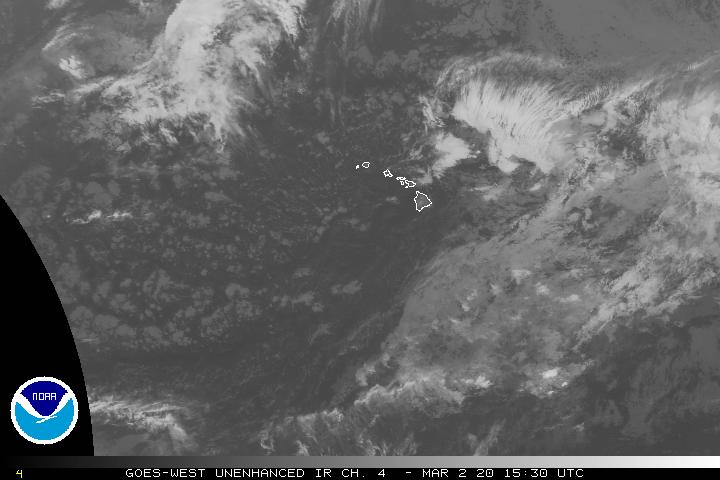Air Temperatures – The following high temperatures (F) were recorded across the state of Hawaii Sunday…along with the low temperatures Sunday:
76 – 65 Lihue, Kauai
83 – 70 Honolulu, Oahu
75 – 67 Molokai
79 – 65 Kahului AP, Maui
81 – 68 Kailua Kona
82 – 63 Hilo AP, Hawaii
Here are the latest 24-hour precipitation totals (inches) for each of the islands as of Sunday evening:
0.81 Kilohana, Kauai
1.23 Tunnel RG, Oahu
1.80 Molokai
0.59 Lanai
0.24 Kahoolawe
1.04 Puu Kukui, Maui
0.02 Saddle Quarry, Big Island
The following numbers represent the strongest wind gusts (mph) as of Sunday evening:
20 Port Allen, Kauai
18 Kuaokala, Oahu
17 Molokai
07 Lanai
22 Kahoolawe
16 Maalaea Bay, Maui
22 Kealakomo, Big Island
Hawaii’s Mountains – Here’s a link to the live webcam on the summit of our tallest mountain Mauna Kea (nearly 13,800 feet high) on the Big Island of Hawaii. This webcam is available during the daylight hours here in the islands, and at night whenever there’s a big moon shining down. Also, at night you will be able to see the stars — and the sunrise and sunset too — depending upon weather conditions.
Aloha Paragraphs

Storms moving by west to east far north of Hawaii

The first of two cold fronts…has become hard to discern

This front is falling apart over Maui County

Showers locally along this dissipating cold front – Looping image
High Surf Advisory…north and west shores of Kauai, Oahu, Molokai, the north shores of Maui and the Big Island
Small Craft Advisory…due to large northwest swell in Maui County and Big Island windward waters
~~~Hawaii Weather Narrative ~~~
Broad Brush Overview: The first of two cold fronts has stalled and is dissipating over the central islands. Winds will quickly shift to the east, then to the south and southwest Monday ahead of a stronger front, which is expected to cross the state Tuesday through Wednesday. Breezy north winds will fill in behind the front Wednesday and Thursday, with unsettled weather possible Thursday night into next weekend…as an upper low develops and drifts over the area from the east.
Details: Satellite imagery and observations show a weak cold front falling apart over Maui County. Radar imagery showed a narrow band of scattered, mainly light, showers along and front, impacting the wind portions of Maui County. The latest rainfall summary showed that peak accumulations associated with this activity across Kauai and Oahu, up to an inch locally. There were similar amounts over Maui County as the front slowed to a stop…although Molokai had more.
Although there is a significant amount of dry air behind the front, it won’t make much southward progress across the state through Monday. The trailing high will quickly pass north of the state, with its surface ridge expected to shift southward over us Monday. We’ll find a period of land and sea breezes, as the low level flow quickly veers from the east tonight…to the south and southwest kona directions Monday.
Looking Further Ahead: A second, stronger cold front will reach Kauai late Monday night into Tuesday, then clearing the Big Island Wednesday through Wednesday night. A deeper source of moisture along and ahead of this boundary is expected. This moisture will bring increased rainfall coverage across the state, as is moves down the island chain. Guidance suggests this boundary pushing east of the state with another shot of cool and dry air arriving Tuesday night. Winds will shift north-northeast and become stronger Wednesday through Thursday.
An active weather pattern will remain in place across the Central Pacific during the next week. Meanwhile, there continues to be forecast uncertainty during the second half of the work week into next weekend. The GFS and ECMWF models both show a cutoff low developing near or just east of the islands Thursday. This upper level feature, and a broad surface trough associated with the frontal boundary that will have pushed through the islands Wednesday, are forecast to slowly drift westward into the area. This in turn could bring unsettled weather, with a chance of heavy rain Friday into next Saturday.
Here’s a wind profile of the Pacific Ocean – Closer view of the islands / Here’s the vog forecast animation / Here’s the latest weather map
Marine environment details: Seas will build rapidly as the next north-northwest swell arrives. A Small Craft Advisory remains in effect for most of the coastal waters. Seas should subside again Monday, although build quickly once again late Tuesday into Wednesday…as another even larger north-northwest swell arrives.
This first swell will produce warning-level surf for north and some west facing shores of most smaller islands, before subsiding on Monday. A High Surf Warning remains in effect through tonight for those areas. North facing shores of the Big Island will be under a High Surf Advisory. Tidal impacts are not expected to be an issue as the predicted astronomical tides are lower than with the last event.
Another even larger north-northwest swell is forecast to arrive Tuesday afternoon, peaking Tuesday night into Wednesday. This swell is expected to produce warning-level surf on north and west facing shores.

Large surf breaking on the north and west shores
World-wide Tropical Cyclone activity
>>> Here’s the latest PDC Weather Wall Presentation, covering a tropical disturbance being referred to as Invest 96W to the east of Palau
![]()
>>> Atlantic Ocean:
>>> Caribbean Sea:
>>> Gulf of Mexico:
Here’s a satellite image of the Caribbean Sea…and the Gulf of Mexico
Here’s the link to the National Hurricane Center (NHC)
>>> Eastern Pacific:
Here’s a wide satellite image that covers the entire area between Mexico, out through the central Pacific…to the International Dateline.
Here’s the link to the National Hurricane Center (NHC)
>>> Central Pacific:
Here’s a link to the Central Pacific Hurricane Center (CPHC)
>>> Northwest Pacific Ocean: No active tropical cyclones
>>> North and South Indian Oceans / Arabian Sea: No active tropical cyclones
Here’s a link to the Joint Typhoon Warning Center (JTWC)
Interesting: Aconcagua: Highest Mountain in South America – Part of the Andes mountain range, Aconcagua is the second highest of the Seven Summits (the highest peaks on each continent), behind only Mount Everest in Asia. At 22,837 feet, not only is it the highest mountain in South America, it is the tallest peak in all of the Americas, as well as the Southern and Western Hemispheres.
Aconcagua is located in Argentina, in the province of Mendoza, and lies 70 miles northwest of the provincial capital, Mendoza, and 9.3 miles from the border with Chile.
To the north and east is Valle de las Vacas, and to the west and south is the Valle de los Horcones Inferior. The mountain is part of the Aconcagua Provincial Park, a protected natural area in the Andes that was established in 1983.
Name origins
It is not exactly known where the name Aconcagua came from. One possible origin is that it derived from the native Quechuan words akun, or “summit,” ka, or “other” and agua, or “admired” or “feared,” according to the Encyclopedia of World Geography. Another possibility is that it comes from Aconca-Hue, an Arauca phrase that translates as “comes from the other side” — meaning the other side of the Aconcagua River.
The name also may be derived from ackon cahuak, Quechuan words meaning “stone sentinel.” Other options for the origin of the name are the Quechuan phrase ancho cahuac or “white sentinel,” or aymara janq’u q’awa, meaning “white ravine.”
Former volcano
The Andes Mountains were formed as the result of subduction of the oceanic Nazca Plate under the South American continent, according to Marieke Dechesne, a geologist with the U.S. Geological Survey. Aconcagua used to be a volcano, when the oceanic plate dipped at a higher angle under the continent.
However, sometime in the Miocene, about 8 to 10 million years ago, the subduction angle started to decrease causing the magma to stop melting and increasing the horizontal stresses between the oceanic plate and the continent, causing the thrust faults that lifted Aconcagua up off its volcanic root.
Life on Aconcagua
The vegetation and wildlife on Aconcagua is concentrated below 13,123 feet, according to the Encyclopedia of World Geography. There are a number of low bushes, such as yellow firewood, yareta and goat horn, and there are open pastures made up of grasses such as huecú and ichu.
Many varieties of birds inhabit the area, including the condor, the purple eagle and a species of snipe called agachona. Spotted sandpipers and torrrentes, a type of duck, thrive in some of the areas with water. Mountain rats and the red fox are among the most common land animals.
Climate at Aconcagua
The mountain is dotted with glaciers, with the largest one being the Ventisquero Horcones Inferior, which is 6.2 miles long and near the Confluencia camp on the south face at about 11,811 feet. Other large glacier systems include Ventisquero de las Vacas Sur, Glaciar Este/Ventisquero Relinchos and the north-eastern or Polish Glacier, which is a popular ascent route.
During the summer, the temperature at night above 16,400 feet is about minus 4F, and the typical temperature at the summit is minus 22F. The cold, snowy and unpredictable conditions discourage most from trying to summit in winter. Climbers sometimes compare the mountain’s difficulty level to that of the “eight-thousanders”: 14 Himalayan and Karakoram mountains more than 26,247 feet above sea level.
Climbing Aconcagua
Climbers of Aconcagua often struggle with low humidity, low oxygen and fierce winds. Storms are often triggered by humid currents of warm sea air coming from the Pacific Anticyclone, a high-pressure system in the southern Pacific Ocean. These south-bound winds clash against the Andes Mountains, cooling and creating snow on the high peaks, according to Aconcagua Treks. In the summer, the mountain also has its share of lightning storms, creating an even greater risk for climbers.
When a storm is present at higher elevations, an enormous “mushroom” cloud can often be seen hovering around the summit. Even when the weather is good at base camps, including Plaza de Mulas Base Camp, the mushroom cloud serves as a warning sign that a fierce storm is occurring higher up and that nobody should attempt to climb to those levels, according to Aconcagua Treks. On the contrary, winds blowing from the south are an indication that good weather is coming.
About 60 percent of climbers who attempt the mountain succeed in summiting. Because it is not a highly technical climb, many mistakenly believe that it will be an easy ascent. More than 135 climbers have died on Aconcagua — primarily because of complications of altitude sickness, but also from falls, heart attacks, hypothermia and other causes due to severe weather — and about three climbers die each year on Aconcagua.
The most common route up Aconcagua is the Normal Route along the Northwest Ridge. In total it takes about 21 days from Mendoza, including hiking to the base of the mountain, establishing camps, doing acclimatization climbs, summiting and descending.
Milestones in Aconcagua history
1883: German mountaineer and explorer Paul Güssfeldt makes the first attempt by a European to reach the summit of Aconcagua. Güssfeldt allegedly bribes some local men to be his porters by telling them there is treasure on the mountain, according to Aconcagua Treks. The team has poor equipment and is forced to head back down only about 1,640 feet from the summit due to extremely dangerous winds.
1897: American-born mountaineer Edward FitzGerald leads the first known ascent of Aconcagua. Swiss climber Mathias Zurbriggen reaches the summit alone on Jan. 14, followed a few days later by Nicholas Lanti and Stuart Vines, who were also members of the expedition team.
1940: French climber Adrienne Bance is the first woman to summit as part of an expedition from of the Andinist Club of Mendoza.
1953: Argentines E. Huerta, H. Vasalla and F. Godoy make the first winter ascent from Sept. 11 to 15.
1984: Titoune Meunier is the first woman to climb the South Face. She reaches the summit, along with her former husband John Bouchard, using the French 1954/Messner route.
1985: A well-preserved skeleton is discovered at 17,060 feet on the southwest ridge of Cerro Pyramidal, an Aconcagua sub-peak, providing evidence that the pre-Colombian Incas had climbed Aconcagua.
2007: Scott Lewis, at 87, is the oldest person to summit when he makes his ascent on Nov. 26.
2013: Tyler Armstrong, a 9-year-old boy from Yorba Linda, Calif., is the youngest to reach the summit.












 Email Glenn James:
Email Glenn James:
Mary O Says:
I was SO disappointed to wake up and find wet pavements and garden; I missed the rain last night here in North Kihei! It’s so rare that I like to make a celebration of it. Aw well…. maybe again this week sometime. Happy Holidays to you and yours, Glenn.
~~~ Hi Mary, I totally understand, I like it to rain when I’m able to watch it!
I was in Makawao last evening having dinner, and I had to run between the car and the front door of the restaurant…as the rains fell briefly.
I think you will get more rain this coming week. I’m a bit disappointed, as I’ll be missing that next cold front…as I fly to San Francisco tomorrow.
Happy Holiday’s to you as well!
Aloha, Glenn
Mark Says:
Hi Glenn,
Any Christmas Crystal ball weather prediction yet?
~~~ Hi Mark, a valid question, although the answer is that I don’t have a clue this early in the month.
Stay tuned…
Aloha, Glenn